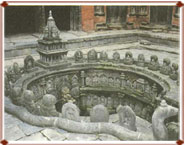Monuments in the Kathmandu Valley, Nepal
© UNESCO 1998
National implementing agency: Department of Archaeology and Museum
Project duration: 1991-1997
Total project cost: US$ 376,300
"Over the centuries, the successive dynasties which established their capitals in the Kathmandu Valley have left behind a rich legacy of palatial structures, temples and monasteries. Heavy traffic is responsible for much of the damage to the monuments.
Heavy rainfall in 1989 also caused damage to some of the most important buildings, including Bishwanath, Sundari Chowk and Mul Chowk in Patan Durbar Square.
In order to support the efforts of the Government of Nepal to preserve these monuments, the following activities were carried out under the project:
-detailed surveys of the square and the selected monuments;
-analysis of the deterioration and the development of suitable methods of treatment ;
-detailed surveys for preservation of monuments, as well as plans for the improvement of Patan Durbar Square ;
-assessment of the needs of the national authorities with a view to increasing their managerial capacity ;
-preparation of an Action Plan for the work, management, promotion and fund raising."
(Extract from "Preservation of Cultural Heritage through the UNESCO/Japanese Trust Fund" p.20)
The Kathmandu Valley is inscribed on the World Heritage List.
Links:
Latest Publication on the International Cooperation through the UNESCO/Japanese Funds-in-Trust (
pdf, 2.91MB)
Second publication (2003) concerning the Japanese Funds-in-Trust Preservation of Cultural Heritage (
pdf, 2.29MB)
First publication concerning the Japanese Funds-in-Trust Preservation of Cultural Heritage (1998) (
pdf, 5.92MB)
Back to : The Japanese Funds-in-trust for the Preservation of World Cultural Heritage
Legal Matters | About Accessibility | Privacy Policy
Copyright : 2013 Permanent Delegation of Japan to UNESCO
